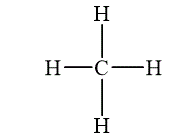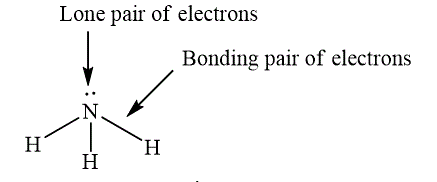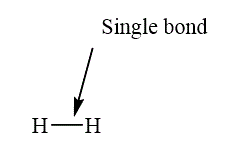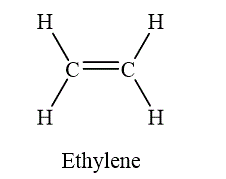
Concept explainers
(a)
Interpretation:
The difference between ionic compound and molecular compound in scientific terms is to be stated.
Concept introduction:
An ionic bond is formed by the transfer of electrons, which is also known as electrovalent bond. The compound which are composed of molecules contain more than one type of atom are called molecular compounds.
Answer to Problem 41E
An ionic compound is formed by the transfer of electrons, while a molecular compounds are composed of molecules contain more than one type of atom.
Explanation of Solution
The compound which contains ionic bond between two or more atoms is known as ionic compound. Ionic bonds are formed between electropositive and electronegative elements, which have larger electronegativity difference. Sodium chloride is an example of ionic compound, which is shown below.
![]()
Figure 1
The compound which is composed of molecules containing more than one type of atom is called molecular compounds. Methane is an example of molecular compound, which is shown below.

Figure 2
An ionic compound is formed by the transfer of electrons, while a molecular compounds are composed of molecules contain more than one type of atom.
(b)
Interpretation:
The difference between ionic bond and covalent bond in scientific terms is to be stated.
Concept introduction:
An ionic bond is formed by the transfer of electrons, which is also known as electrovalent bond. Ionic bonds are formed between electropositive and electronegative elements. A covalent bond is formed by the mutual sharing of electrons. The number of electrons contributed by each atom is known as covalence of the atom. The covalent bond is stronger than ionic bonds because of sharing of the electrons.
Answer to Problem 41E
An ionic bond is formed by the transfer of electrons, while a covalent bond is formed by the mutual sharing of electrons.
Explanation of Solution
An ionic bond is formed by the transfer of electrons, which is also known as electrovalent bond. Ionic bonds are formed between electropositive and electronegative elements. Sodium chloride is an example that includes ionic bonding, which is shown below.
![]()
Figure 1
A covalent bond is formed by the mutual sharing of the electrons. The number of electrons contributed by each atom is known as covalence of the atom. Hydrogen chloride is an example that describes covalent bonding, which is shown below.
![]()
Figure 3
An ionic bond is formed by the transfer of electrons, while a covalent bond is formed by the mutual sharing of electrons.
(c)
Interpretation:
The difference between lone pair and bonding pair in scientific terms is to be stated.
Concept introduction:
Lone pair of electrons is the type of electrons, which do not participate in the bond formation. Bonding pair of electrons are type of electrons, which participate in the bond formation and present between the bonded atoms.
Answer to Problem 41E
Lone pair of electrons are electrons, which do not take participate in the bond formation, while bonding pair of electron are electrons, which participate in the bond formation.
Explanation of Solution
Lone pair of electrons are electrons, which do not participate in the bond formation. Lone pair of electrons are localized on the atom. Bonding pair of electron are electrons, which participate in the bond formation and present between the bonded atoms. The example, which shows lone pair and bonding pair is shown below.

Figure 4
Loan pair of electrons are electrons, which do not participate in the bond formation, while bonding pair of electron are electrons, which participate in the bond formation.
(d)
Interpretation:
The difference between nonpolar bond and polar bond in scientific terms is to be stated.
Concept introduction:
Polar and non polar bonds are the type of covalent bond. A polar bond is formed between atoms of different elements, having some value of electronegativity difference. A non polar bond is formed between atoms of same elements.
Answer to Problem 41E
A polar bond is formed between atoms of different elements, while a non polar bond is formed between atoms of same elements.
Explanation of Solution
A polar bond is formed between atoms of different elements, having some value of electronegative difference. A non polar bond is formed between atoms of same elements.
The example of polar and non polar bond is shown below.

Figure 5
A polar bond is formed between atoms of different elements, while a non polar bond is formed between atoms of same elements.
(e)
Interpretation:
The difference among single, double, triple, and multiple bonds in scientific terms is to be stated.
Concept introduction:
If two atoms are bonded with the sharing of one pair of electron, such a bond is called as single bond. If two atoms are bonded by the sharing of two pairs of electrons, such a bond is called as double bond.
Answer to Problem 41E
Single bond is formed by the sharing of one pair of electron between two atoms. Double bond is formed by the sharing of two pair of electron between two atoms. Triple bond is formed by the sharing of three pair of electron between two atoms. Multiple bonds is the general term that includes double and triple bonds.
Explanation of Solution
If two atoms are bonded with the sharing of one pair of electron, such a bond is called as single bond. The example of a single bond is shown as below.

Figure 6
If two atoms are bonded by the sharing of two pairs of electrons, such a bond is called as double bond. The example of double bond is shown as below.

Figure 7
If two atoms are bonded by three pairs of electrons, such bond is called as triple bonds. The example of triple bond is shown as below.
![]()
Figure 8
Multiple bonds is a general term that includes double and triple bonds. The example of multiple bond is shown as below.

Figure 9
Single bond is formed by the sharing of one pair of electron between two atoms. Double bond is formed by the sharing of two pair of electron between two atoms. Triple bond is formed by the sharing of three pair of electron between two atoms. Multiple bonds is a general term that includes double and triple bonds.
Want to see more full solutions like this?
Chapter 12 Solutions
Introductory Chemistry: An Active Learning Approach
- Q14. Fill this chart: (please refer to ppt notes/browser to answer these questions) What alcohol is also called wood alcohol? What is the common name of ethanol? Draw the structure of phenol and thiophene? Are bigger chain alcohol like heptanol and octanol are soluble or insoluble in water and explain it ? Are ethers soluble or insoluble in water? What suffix and prefix are used for alcohol while naming alcohol and ether? What the process called when we add water to any alkene to make alcohol? Q16. Draw the diagram of following aromatic compound (practice from previous module) Aniline Phenol Benzoic acid Methyl benzoate Q17. a. Write the oxidation reactions for the 2 propanol. b. Write the oxidation reaction of the ethanol.arrow_forwardQuestion 11 of 18 (1 point) Question Attempt: 3 of How many signals do you expect in the 'H NMR spectrum for this molecule? Br Br Write the answer below. Also, in each of the drawing areas below is a copy of the molecule, with Hs shown. In each copy, one of the H atoms is colored red. Highlight in red all other H atoms that would contribute to the same signal as the H already highlighted red. Note for advanced students: In this question, any multiplet is counted as one signal. Number of signals in the 'H NMR spectrum. 1 For the molecule in the top drawing area, highlight in red any other H atoms that will contribute to the same signal as the H atom already highlighted red. If no other H atoms will contribute, check the box at right. No additional Hs to color in top molecule Check For the molecule in the bottom drawing area, highlight in red any other H atoms that will contribute to the same signal as the H atom already highlighted red. If no other H atoms will contribute, check the box…arrow_forwardOrganic Chemistry Esterification reactions 1. Write the steps to prepare ester. 2. Write complete reaction of ethanol and acetic acid to make ester. 3. What does ester smell like? What are the uses of ester. 4. What the role of sulfuric acid in the esterification reactionarrow_forward
- 11. Complete the following esterification reaction with names of all the reactants and products under. Hint: Remove the water and end up with ester R-C-OH + ROH R-C-OR + H₂O A carboxylic acid An alcohol An ester Water BYJU'S H-C-C O-H Нин C-C-C-H HAAA H O-C-C-C-H AAA Ethanoic acid Propanol Water Propyl ethanoate By com CH3COOH + CH3CH2CH2CH₂CH₂OH → Practice for alcohols aldehydes and ketones: 12. Draw the structures from the following names mixed of alcohol/aldehyde and ketone: a. 4-methyl cyclohexanone b. 3-methyl-2-pentenal c. 2,3-dimethylcyclohexanone d. 1,3propanediol or Propane 1,3 diol 13. Write systematic names for the following compounds identify functional group: a. b. (CH3)2CH-C OH c) CH(CH₂)-- OH -,-,arrow_forwardmay you please show all steps! i am having a hard time understanding and applying in this format, thank you!arrow_forward10. Complete the substitution reaction of 2 pentanol with these reagents. Reagents & Reaction Conditions use practice sheet. Please write only major products, minor product like water, other gases are not required. Hint: In substitution of alcohol, we generally substitute OH group with Halogens like cl, Br, F using some reagent containing halogens. Ensure to add halogens to the same carbon number where you are removing OH from Examples Alcohols can be converted to Alkyl Halides with HX acids HBr H₂O HCI + H₂O HI + H₂O CH,CH₂OH + SOCI₂ CH,CH₂OH + PCI₁₂ A BBYJU'S CH CHCI + SO₂+ HCI CH₂CH CIP(OH), + HCI CH,CH₂OH + PCI CHCHCI + POCI + HCI CH,CH₂OH + PBr, CH,CH,Br + P(OH), + HBr 1. Reaction with HBr with 2 Pentanol 2.Reaction with HI with 2 pentanol © Byjus.com 3.Reaction with HCI+ZnCl,, with 2 pentanol (Zncl2 is catalyst no role) 4.Reaction with SOCI,, with 2 Pentanol 5.Reaction with PBr; or PCl, with 2 pentanolarrow_forward
- 3. Is 2-methyl-2-propanol a primary, secondary, or tertiary alcohol? Write out the structures of 2-methyl-2-propanol and also any oxidation products of 2- methyl-2- propanol. If there is more than one oxidation product, give the structure of each of the products. 4. 2-Propanol is the IUPAC systematic name of this alcohol. It has a common name by which it is much better known (You'll see it in the grocery store or pharmacy). Give that common name 5. Aldehydes can be synthesized by the oxidation of. Please choose from below choices A. Primary alcohols B. Secondary alcohols C. Organic acids D. Inorganic acids 6. Tertiary alcohol Can undergo oxidation. yes or no. ? If yes then answer the product.arrow_forwardFinish the reactions hand written pleasearrow_forwardPart A Identify each alcohol as primary, secondary, or tertiary Drag the appropriate items to their respective bins. CH₂ H₂C- -C-OH HO CH₂ Primary Он OH CH₂ OH CCH₂OH CH₂ сн Secondary Tertiary Reset Help CH,CH₂ (CH)CHCH,OH CH,CH,CH,CCH, CHOH CH₂ Different types of alcohol groups Alcohol and its reaction: 8. Combing two alcohol molecules below and completing the reaction with Product .( Hint Reaction called etherification as ether is formed and name the ether once you complete the reaction. Hint.: R-O-H+H-O-RR-O-R Do the reaction: CH₂OH + CH₂OH---→ + H-O-H 9. Write the reaction of formation of alcohol from alkene by adding water: Addition reaction also called hydration reaction as we are adding water which occur always in presence of acid Hint: Break the double bond and add H and OH if symmetrical then add anywhere if unsymmetrical then follow Markovnikov rule H should go to that double bone carbon which has more hydrogen CH2=CH2 + H₂O-→arrow_forward
- Complete the reaction hand written pleasearrow_forwardPredict the major products of this organic reaction: HBr (1 equiv) cold ? Some important notes: • Draw the major product, or products, of this reaction in the drawing area below. • You can draw the products in any arrangement you like. • Pay careful attention to the reaction conditions, and only include the major products. • Be sure to use wedge and dash bonds when necessary, for example to distinguish between major products that are enantiomers. • Note that there is only 1 equivalent of HBr reactant, so you need not consider the case of multiple additions. dm Re Explanation Check ©2025 McGraw Hill LLC. All Rights Reserved. Termarrow_forwardb) Use curved arrows to show the reaction of the radical with hydrogen bromide. Br: Br H .. Answer Bankarrow_forward
- Chemistry: Matter and ChangeChemistryISBN:9780078746376Author:Dinah Zike, Laurel Dingrando, Nicholas Hainen, Cheryl WistromPublisher:Glencoe/McGraw-Hill School Pub Co
 Living By Chemistry: First Edition TextbookChemistryISBN:9781559539418Author:Angelica StacyPublisher:MAC HIGHER
Living By Chemistry: First Edition TextbookChemistryISBN:9781559539418Author:Angelica StacyPublisher:MAC HIGHER Chemistry for Today: General, Organic, and Bioche...ChemistryISBN:9781305960060Author:Spencer L. Seager, Michael R. Slabaugh, Maren S. HansenPublisher:Cengage Learning
Chemistry for Today: General, Organic, and Bioche...ChemistryISBN:9781305960060Author:Spencer L. Seager, Michael R. Slabaugh, Maren S. HansenPublisher:Cengage Learning  World of Chemistry, 3rd editionChemistryISBN:9781133109655Author:Steven S. Zumdahl, Susan L. Zumdahl, Donald J. DeCostePublisher:Brooks / Cole / Cengage Learning
World of Chemistry, 3rd editionChemistryISBN:9781133109655Author:Steven S. Zumdahl, Susan L. Zumdahl, Donald J. DeCostePublisher:Brooks / Cole / Cengage Learning
 Introductory Chemistry: An Active Learning Approa...ChemistryISBN:9781305079250Author:Mark S. Cracolice, Ed PetersPublisher:Cengage Learning
Introductory Chemistry: An Active Learning Approa...ChemistryISBN:9781305079250Author:Mark S. Cracolice, Ed PetersPublisher:Cengage Learning





